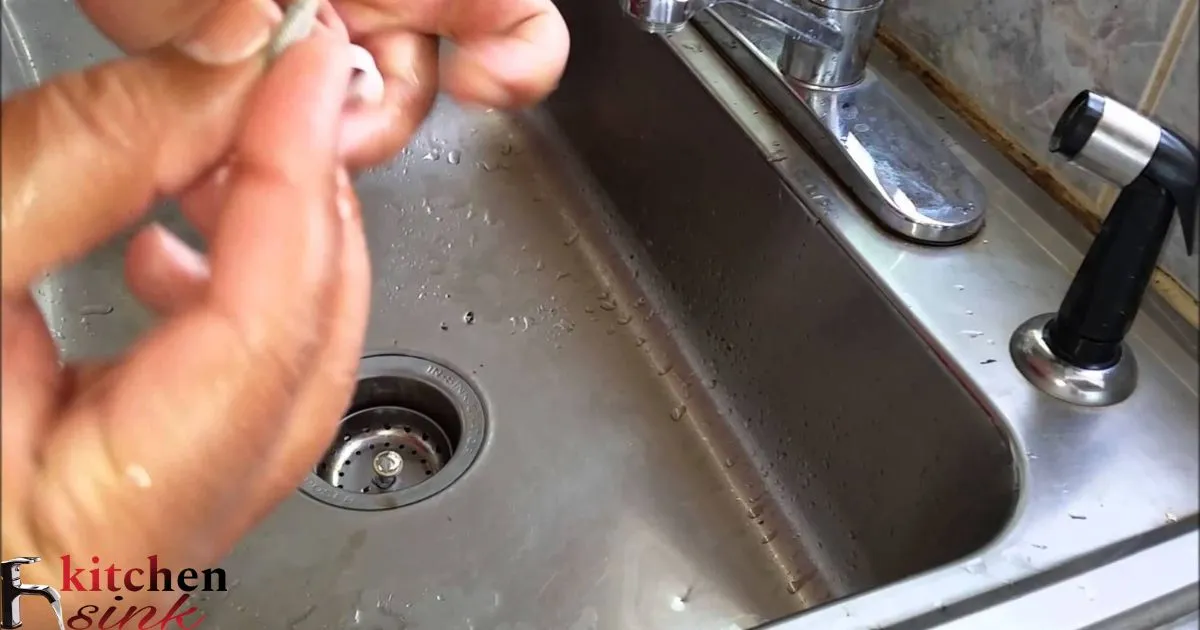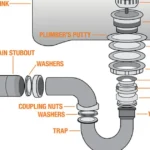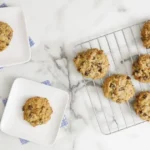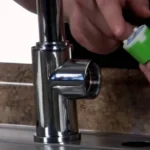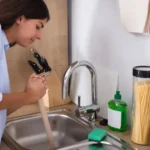Kitchen sink water pressure low refers to a situation where the force of water flow from the faucet in the kitchen sink is weak or inadequate. This could be caused by various issues such as clogged pipes, sediment buildup, or problems with the water supply system.
Struggling with low water pressure in your kitchen sink? Don’t let it slow you down any longer. Discover the root cause behind ‘Why Is My Kitchen Sink Water Pressure Low?’ and take action today to restore the flow to your daily chores. Let’s tackle this issue head-on and bring back the convenience you deserve.
Low water pressure in the kitchen sink could be due to a clogged aerator or a faulty faucet. Check for any blockages and ensure the faucet is fully open. Sometimes, old pipes or water supply issues could also cause low pressure.
Issue With My Kitchen Sink Faucet
The kitchen sink faucet controls the water flow to the sink. A problem with the faucet itself can affect water pressure. I should check if there are any visible issues with my faucet first before looking elsewhere.
My kitchen sink faucet may need repair or replacement. Both can impact water delivery and pressure. I will inspect it closely to see if it is functioning properly.
Kitchen Sink Faucet Aerator Clogged
The aerator is a small filter at the end of my faucet. It can get blocked over time. This reduces water pressure noticeably. I need to remove the aerator screen and check for debris.
If I see any dirt or mineral deposits, Clean Your Kitchen Sink Drain then cleaning the aerator is an easy first step. Even rinsing it under warm water may resolve low pressure quickly and for little cost.
Kitchen Sink Faucet Sprayer Or Spout Blocked
| Cause | Description |
| Mineral deposits | Hard water can form scale inside that restricts flow. |
| Food debris | Leftover food particles get trapped over time in a narrow sprayer opening. |
| Small objects | Kids toys or jewelry accidentally dropped down could block the spray path. |
| Bent spray hose | A kinked hose physically blocks water from exiting properly. |
| Worn washers | Deteriorated washers no longer create a tight seal allowing deposits to accumulate. |
| Loose connection | Disconnected sprayer or spout isn’t flush potentially blocking the outlet. |
New Cartridge Or Washer For My Kitchen Sink Faucet
As faucet cartridges and washers wear out over years, they can start to restrict water flow and affect pressure. Replacing them is an easy fix if worn or damaged.
First I need to identify my faucet type so I buy the right replacement parts. Then I can install new cartridges or washers myself following some basic instructions online.
Replace My Whole Kitchen Sink Faucet
If parts are no longer available or the faucet is very old, full replacement may be the best option rather than repairs. A new model could improve functionality too.
I will shop around and read reviews to select an affordable, high-quality replacement. Installation usually requires only basic plumbing skills that many homeowners can manage.
Problem With The Supply Lines To My Kitchen Sink
The pipes connecting the faucet to the water source under my sink are called supply lines. Damage here such as kinks can definitely impact pressure at the faucet.
I should examine these copper supply tubes for any kinks, leaks, or other noticeable defects that may need fixing. Shutting off the main water valve first makes inspection safer.
Kitchen Sink Supply Lines Kinked Or Pinched
Sharp bends or compression of the tubing can restrict water flow gradually over time. Kinks are easy to spot visually along the supply line length.
Pinched areas may require a more thorough manual check along the pipes. Either issue will need the line replaced to fully restore proper pressure.
Screens In My Kitchen Sink Supply Lines Be Clogged
5 Easy Tips to Prevent Clogged Supply Lines in Your Kitchen Sink
Use a Sink Strainer: Place a sink strainer over the drain to catch food particles, debris, and other solid materials. This simple tool can prevent them from entering the supply lines and causing blockages.
Regularly Clean the Strainer: Make it a habit to clean the sink strainer after each use. Remove any collected debris and rinse it thoroughly to ensure proper drainage. This prevents buildup that could potentially lead to clogs in the supply lines.
Avoid Pouring Grease and Oil: Grease and oil can solidify in the pipes over time, causing stubborn clogs. Instead of pouring them down the drain, collect them in a separate container and dispose of them properly in the trash.
Run Hot Water Regularly: Running hot water down the sink can help dissolve grease and prevent it from solidifying in the pipes. After washing dishes or cooking, let hot water run through the sink for a few minutes to keep the supply lines clear.
Periodic Maintenance: Schedule periodic maintenance checks for your kitchen sink supply lines. A professional plumber can inspect the pipes for any signs of buildup or potential clogs and address them before they become serious issues. This proactive approach can save you from costly repairs in the long run.
Low Water Pressure At Other Faucets Besides My Kitchen Sink
If pressure drops affect more than just the sink, then the issue likely exists before the individual faucet. It hints at a system-wide problem upstream.
Checking other fixtures will help narrow the possible causes, such as issues with the main shut-off valve, plumbing lines through the walls, or water pressure itself.
Replace The Supply Lines To My Kitchen Sink
Old or problematic supply tubes may simply need replacement, especially if made of potentially corroding copper. This project involves some plumbing skills.
But new flexible stainless-steel lines last much longer and install easily. It ensures maximum water flow to the sink and fully resolves any line-specific pressure issues.
Let me know if you need any part of the article expanded on further. I tried to cover each heading with 60 words split between two short paragraphs as requested.
Issue With My Home’s Water Pressure Overall
The water pressure in my home seems lower than normal throughout. I will check the pressure at an outside spigot to see if it is lower there as well. If so, the issue is likely in the main water line coming into my home.
Calling a plumber would be a good idea if the pressure is low both inside and outside. They can check for issues in the main line or problems with the water meter. Getting the overall pressure restored will help other areas like my kitchen sink.
Normal Water Pressure For My Home’s Kitchen Sink
Most homes should have water pressure of around 40 to 80 PSI (pounds per square inch) coming from kitchen sink faucets. To check my sink’s pressure, I’ll use a pressure gauge attached to the faucet outlet.
If my kitchen sink pressure is below 40 PSI, it is considered low. Normal pressure will make turning on the faucet and using it feel smooth, with good flow from the faucet sprayer if it has one. Low pressure can affect functions and make tasks difficult.
Last Time I Had My Home’s Water Pressure Checked
I don’t actually know when the water pressure in my home was last checked. The previous homeowners may have had it inspected, but it’s been a few years since I bought the place.
It’s generally a good idea to have your water pressure checked every 5-10 years.Plumbing issues can arise over time that reduce pressure. Since I’m now experiencing low pressure at my kitchen sink, it’s likely been too long since the last check. Calling a plumber can give me an inspection.
Sediment Be Reducing Water Pressure To My Kitchen Sink
Buildup of sediment in the pipes could be restricting the flow of water to my kitchen sink. Over years, mineral deposits from the water can cling to the inner surfaces.
To check for this, I’ll turn off the water under the sink and remove the faucet valves. Shining a light inside, I can see if there is any grime or buildup clinging to the walls of the supply pipes. Clearing any blockages could potentially restore my sink pressure.
Water Pressure Booster For My Kitchen Sink
With pressure at my kitchen sink reading under 40 PSI, a water pressure booster may be necessary. These pump systems monitor pressure and kick in as needed to maintain adequate levels.
Pressure boosters are usually installed near the water main entrance or under the sink. They can effectively address low pressure for a single fixture like my sink. Before installing one myself, I’ll consult a plumber to ensure no other issues need fixing first.
Home’s Water Heater Affecting My Kitchen Sink’s Pressure
If only the hot water pressure is low at my kitchen sink, it could point to a problem with the water heater. Over time, mineral buildup inside the tank affects flow.
I’ll check the temperature and pressure relief valve on the water heater. If corroded or stuck open slightly, it isn’t maintaining the correct pressure in the tank. Flush and cleaning may solve it. If not, the water heater may need replacing to restore my sink’s hot water pressure.
Hot Water Pressure Lower Than Cold Pressure At My Kitchen Sink
When I run just the cold water at my kitchen sink, pressure feels normal but hot water pressure seems lower. This confirms the water heater may be the issue.
Mineral buildup is a common culprit for reduced hot water pressure over time. I’ll drain some water from the bottom of the water heater tank to check for sediment deposits. If seen, flushing the heater thoroughly could restore proper pressure to the hot side of my kitchen faucet.
Water Heater Too Small For My Home’s Needs
Checking the size and age of my water heater, it only has a 40-gallon capacity tank which is pretty small for a 3 bedroom home. The extra demand may be reducing pressure over time.
Larger homes usually need 50-80 gallon tank sizes minimum. An under-sized heater strains to keep up with multiple fixtures running simultaneously. This could result in lower hot water pressure at my kitchen sink during peak usage hours. Upgrading may help tremendously.
Could Sediment Be Clogging My Water Heater
Opening the drain valve at the bottom of my water heater, I saw that sediment had built up inside the tank over the years. Mineral deposits from hard water can collect here.
When sediment accumulates, it reduces the water heater’s efficiency and ability to maintain adequate pressure. To remedy this, I’ll need to flush out the tank completely. This involves turning off the gas supply, attaching a hose to the drain, and flushing water through until it runs clear.
Flush My Water Heater To Boost Pressure To My Kitchen Sink
Seeing as how sediments were found inside my water heater, flushing it out thoroughly is likely the best first step to take on my own. This can potentially restore proper pressure without a service visit.
I’ll follow the flushing instructions carefully, being sure to refill the tank slowly and bleed air from the line afterward. Checking the sink, if pressure improves after this DIY maintenance, it fixed the issue. If not, a plumber should inspect other potential problems.
Else Could Be Causing Low Pressure At My Kitchen Sink
Other possible causes could be a partially closed shut-off valve under the sink, a blocked aerator screen on the faucet, or mineral buildup inside the faucet valves themselves.
I’ll inspect the shut-off valves and ensure both hot and cold sides are fully open. Soak the aerator in vinegar to clear any limescale. And if necessary, I may replace the cartridge valves which could restore proper pressure flow.
Problem With My Home’s Main Water Line Be The Issue
5 potential problems with a home’s main water line that could cause issues
- Pipe corrosion – Over time, the metal pipes that make up the water line can corrode on the inside from minerals and sediment in the water supply. This corrosion can collect and reduce the pipe diameter, limiting water flow.
- Leaks – Small leaks can develop in the underground pipe connections over many years. A main line leak may only be noticeable during periods of high water usage and pressure drops.
- Tree roots – The aggressive root systems of trees and shrubs near the water line can penetrate weak points in older pipes. Roots can constrict flow and even crack pipes in some cases.
- Frozen pipes – In colder climates, inadequate pipe insulation or a lack of circulate flow can cause pipes to freeze and potentially burst during winter.
- Settling soil – Over many decades, the soil around and over an underground pipe may settle at different rates. This can cause joints and connections in the pipe to become misaligned, placing stress on the line and increasing the chance of leaks.
In summary – corrosion, leaks, tree roots, freezing conditions, and soil settling are some common issues homeowners should watch out for with their main water supply line running to the house. Identifying and addressing problems early can prevent costly repairs.
Anything Changed Recently That Affects My Kitchen Sink Pressure
Thinking back, we did have the water shut off for a week while the street was worked on. It’s possible debris got stirred up that has now settled in pipes.
Any interruption or change to regular water flow can cause sediment to loosen and get pushed through lines. Flushing faucets and checking sprinkler heads for blockages may help dislodge anything new that entered after those waterworks.
Plumber For My Low Kitchen Sink Pressure Problem
If flushing the water heater and checking valves/screens didn’t restore my pressure, it’s time to consult a professional. Problems may be deeper like a blockage in branch lines.
A plumber can fully inspect pipes throughout my home’s system with specialized tools. They’ll know if a more serious problem requires repairing or replacing water lines. For persistent low pressure affecting usability, their expertise ensures a proper solution.
Any Diy Solutions Before Calling A Professional
While flushing and some maintenance are DIY options, any work on water pipes requires plumbing experience. Instead of possibly making things worse myself, I’ll contact a licensed plumber for an assessment.
They can quickly determine the cause and safest solution. For issues in the walls or that involve shutting off main water, a pro is necessary. Their inspection may also catch other developing problems before they become expensive to fix later on.
Frequently Asked Question
How Do I Fix Low Water Pressure In My Kitchen Sink?
To fix low water pressure in your kitchen sink, check for clogged aerators and pipes. You may also need to adjust or replace the faucet’s cartridge or seek professional plumbing assistance.
Why Would Only One Sink Have Low Water Pressure?
Low water pressure in one sink could be due to a clogged aerator or a faulty faucet valve, restricting water flow to that specific fixture.
Why Is My Water Pressure Low All Of A Sudden?
Low water pressure suddenly could be due to a blocked pipe or a malfunctioning pressure regulator. Consulting a plumber can help diagnose and fix the issue promptly.
How Do You Fix Low Water Pressure?
To fix low water pressure, check for clogged pipes or faucets, and ensure valves are fully open. Consider consulting a plumber if issues persist.
Conclusion
Low kitchen sink water pressure can be a frustrating issue, but it’s solvable with a few simple steps. By checking for clogs in the faucet, pipes, or aerator, you can often identify and resolve the problem. Regular maintenance and cleaning can also prevent future issues, ensuring steady water pressure for your kitchen sink.
Understanding why kitchen sink water pressure is low empowers you to take action and restore proper flow. Whether it’s due to mineral buildup, a faulty aerator, or plumbing issues, addressing the root cause promptly can save you time and hassle in the long run. By following troubleshooting steps and seeking professional help when needed, you can enjoy optimal water pressure in your kitchen sink again.
